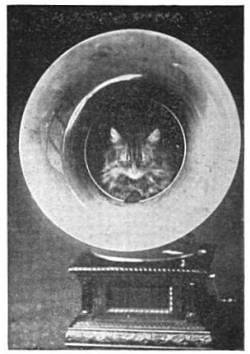
This cat has a liking for the gramophone: it loves to get in the trumpet to sleep, and will not move even when a record is put in and played!
— Strand, August 1906

This cat has a liking for the gramophone: it loves to get in the trumpet to sleep, and will not move even when a record is put in and played!
— Strand, August 1906
A curious legend attends the Viscounts Gormanston of Ireland. It is said that when the head of the house dies, the foxes leave the surrounding countryside and congregate at the door of the castle. The following statements, collected at the death of Jenico William Joseph, the 14th Viscount Gormanston, on Oct. 28, 1907, appeared in the New Ireland Review of April 1908:
“We venture no comment on the evidence,” the editors write. “Our readers will appreciate it for themselves. Whatever be their interpretation of the facts, they will, at least, allow that in them there is something of the marvellous.”

A tangram paradox from Sam Loyd’s Eighth Book of Tan (1903). Each of these cups was composed using the same seven geometric shapes. But the first cup is whole, and the others contain vacancies of different sizes.
“Of course it is a fallacy, a paradox, or an optical illusion, for you will say the feat is impossible!” But how is it done?
nikhedonia
n. the pleasure of anticipating victory or success
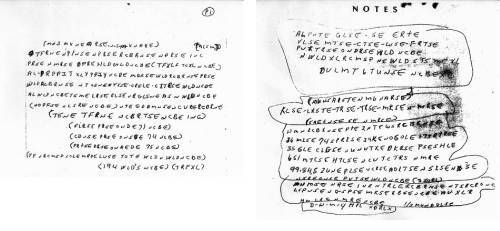
On June 30, 1999, sheriff’s officers discovered the body of 41-year-old Ricky McCormick in a field in St. Louis. In his pockets were the two hand-printed documents above. Both the FBI and the American Cryptogram Association have failed to decipher the notes, so they’ve issued an appeal for help from the public.
Investigators believe the notes were written up to three days before McCormick’s death; his family says he’d used such encrypted notes since he was a boy. “Breaking the code could reveal the victim’s whereabouts before his death and could lead to the solution of a homicide,” said Dan Olson, chief of the FBI’s Cryptanalysis and Racketeering Records Unit. “Not every cipher we get arrives at our door under those circumstances.”
This is not an April Fools’ joke — the FBI’s appeal, including larger versions of the images, is here.
(Thanks, Bunk.)
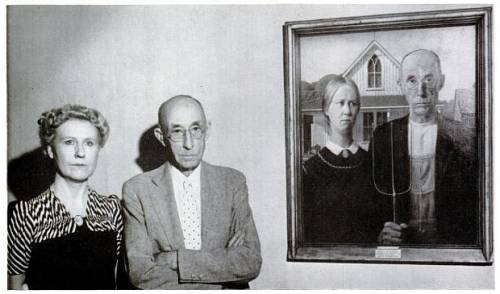
Grant Wood’s American Gothic is a bit ersatz — the artist recruited a Cedar Rapids dentist, B.H. McKeeby, to pose as the farmer, and his sister Nan plays the woman (conceived as the farmer’s spinster daughter, not his wife).
But the setting was inspired by a real cottage in Wood’s native Iowa, and by his admiration for “the kind of people I fancied should live in that house.”
“I tried to characterize them honestly, to make them more like themselves than they are in actual life,” he said. “To me they are basically good and solid people.”
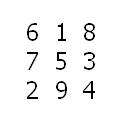
The lowly 3×3 magic square has modest pretensions — each row, column, and diagonal produces the same sum.
But perhaps it’s magicker than we suppose:
6182 + 7532 + 2942 = 8162 + 3572 + 4922 (rows)
6722 + 1592 + 8342 = 2762 + 9512 + 4382 (columns)
6542 + 1322 + 8792 = 4562 + 2312 + 9782 (diagonals)
6392 + 1742 + 8522 = 9362 + 4712 + 2582 (counter-diagonals)
6542 + 7982 + 2132 = 4562 + 8972 + 3122 (diagonals)
6932 + 7142 + 2582 = 3962 + 4172 + 8522 (counter-diagonals)
(R. Holmes, “The Magic Magic Square,” The Mathematical Gazette, December 1970)
More: Any of the equations above will still hold if you remove the middle digit or any two corresponding digits in each of the six addends.
Yet more: (6 × 1 × 8) + (7 × 5 × 3) + (2 × 9 × 4) = (6 × 7 × 2) + (1 × 5 × 9) + (8 × 3 × 4)
I think everything above will work for any rotation or reflection of the square (that is, for any normal 3×3 magic square). I haven’t checked, though.
If you have ever, like me,
Missed the “r” and hit the “t,”
Addressing some fat blister
As “Mt.” instead of “Mr.,”
I trust you left it unamended?
Splendid.
— J.B. Boothroyd, Punch, 1948
In a 1772 letter to Joseph Priestley, Ben Franklin described a method “for arriving at decisions in doubtful cases.” He would divide a sheet of paper into two columns, labeled Pro and Con, and during the course of three or four days record all the motives for and against the idea. Then he’d assign a weight to each consideration. Where he could find arguments, sometimes in combination, that counterbalanced one another, he would strike them out:
Should I enter into business with Mr. Smith?

(This example is from Paul C. Pasles, Benjamin Franklin’s Numbers, 2008.) This exercise would show him where the balance lay, and if after a day or two of further reflection no additional considerations occurred to him, he would come to a decision.
“Though the weight of reasons cannot be taken with the precision of algebraic quantities, yet, when each is thus considered separately and comparatively, and the whole lies before me, I think I can judge better, and am less liable to make a rash step; and in fact I have found great advantage from this kind of equation, in what may be called moral or prudential algebra.”
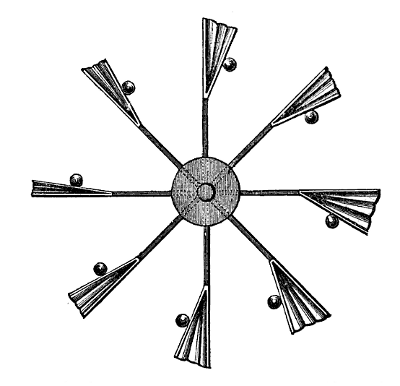
A perpetual-motion scheme from Henry Dircks’ Perpetuum Mobile (1861). Each bellows is fitted with a weight and filled with quicksilver, and a canal connects each opposing pair of bellows. Thus the weights will continually compress the bellows on the left and expand those on the right, forcing the quicksilver always into the rightmost bellows and ensuring that the wheel turns forever. Won’t they?